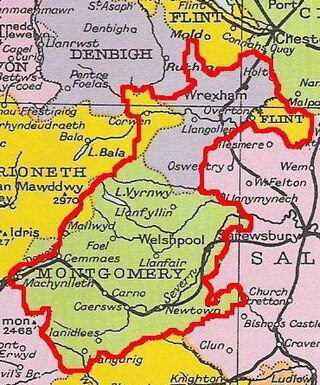
The Kingdom of Powys was a Welsh successor state, petty kingdom and principality that emerged during the Middle Ages following the end of Roman rule in Britain. It very roughly covered the northern two-thirds of the modern county of Powys and part of today's English West Midlands. More precisely, and based on the Romano-British tribal lands of the Ordovices in the west and the Cornovii in the east, its boundaries originally extended from the Cambrian Mountains in the west to include the modern West Midlands region of England in the east. The fertile river valleys of the Severn and Tern are found here, and this region is referred to in later Welsh literature as "the Paradise of Powys".
The Maelor is an area of north-east Wales along the border with England. It is now entirely part of Wrexham County Borough.

Sycharth is a motte and bailey castle and town in Llansilin, Powys, Wales. Until 1996 Sycharth was in the historic county of Denbighshire, but was then transferred to the Shire area of Montgomeryshire within Powys. Sycharth Castle was the birthplace of Owain Glyndŵr.

Madog ap Maredudd was the last prince of the entire Kingdom of Powys, Wales and for a time held the Fitzalan Lordship of Oswestry.

Powys Fadog was the northern portion of the former princely realm of Powys, which split in two following the death of Madog ap Maredudd in 1160. The realm was divided under Welsh law, with Madog's nephew Owain Cyfeiliog inheriting the south and his son Gruffydd Maelor I, who inherited the north.

Gruffydd Maelor was Prince of Powys Fadog in Wales.
Madog ap Gruffudd, or Madog ap Gruffudd Maelor, was Prince of Powys Fadog from 1191 to 1236 in north-east Wales.
Gruffydd Maelor II was Prince of Powys Fadog.
Madog Crypl, also known as Madog ap Gruffydd Fychan was a descendant of the sovereign Princes of Powys Fadog and Lords of Dinas Bran. He is sometimes described as Madog III of Powys Fadog. However, he was only lord of some of the family lands under the English crown.

Chirkland was a marcher lordship in north-east Wales. It was created in 1282 from parts of Powys Fadog granted to Roger Mortimer de Chirk, third son of Roger Mortimer, 1st Baron Mortimer of Wigmore, who then built Chirk Castle from where the lordship was administered.

Ial or Yale was a commote of medieval Wales within the cantref of Maelor in the Kingdom of Powys. When the Kingdom was divided in 1160, Maelor became part of the Princely realm of Powys Fadog, and belonged to the Royal House of Mathrafal.

Nanheudwy was a medieval commote of Wales considered part of the ancient Kingdom of Powys in the cantref of Swydd y Waun. It was traditionally defined as the region between the valleys of the rivers Dee and Ceiriog with a mountain ridge running along its length. Its name may be from "Nannau Dwy" meaning "Glens of the Dee".

The Royal House of Mathrafal began as a cadet branch of the Welsh Royal House of Dinefwr, taking their name from Mathrafal Castle, their principal seat and effective capital. They effectively replaced the House of Gwertherion, who had been ruling the Kingdom of Powys since late Roman Britain, through the politically advantageous marriage of an ancestor, Merfyn the Oppressor. His son, King Bleddyn ap Cynfyn, would join the resistance of the Anglo-Saxon King Harold Godwinson, against the invasion of William the Conqueror, following the Norman conquest of England. Thereafter, they would struggle with the Plantagenets and the remaining Welsh Royal houses for the control of Wales. Although their fortunes rose and fell over the generations, they are primarily remembered as Kings of Powys and last native Prince of Wales.

Tudur ap Gruffudd (1365–1405), also known as Tudor de Glendore or Tudor Glendower, was the Lord of Gwyddelwern, a junior title of the Princely house of Powys Fadog, and was the younger brother of Owain Glyndŵr, the Welsh rebel leader crowned Prince of Wales. His father was Gruffydd Fychan II, the hereditary Prince of Powys Fadog and previous Lord of Gwyddelwern. Along with his brother, Owain Glyndŵr, Tudur was a member of the Royal House of Mathrafal.
Gruffudd Fychan could refer to:
Fychan is a surname. Notable people with the surname include:

Cyfeiliog was a medieval commote in the cantref of Cynan of the Kingdom of Powys. Cynan also contained the commote of Mawddwy. Other sources refer to Cyfeiliog as a cantref in its own right, possibly as a result of Cynan's being renamed for the largest commote within it.

Mochnant was a medieval cantref in the Kingdom of Powys.

Ystrad Marchell was a medieval commote in the cantref of Ystlyg in the Kingdom of Powys. It roughly coincides with the parish of Welshpool.

There are multiple buildings and sites associated with Owain Glyndwr in Wales.











